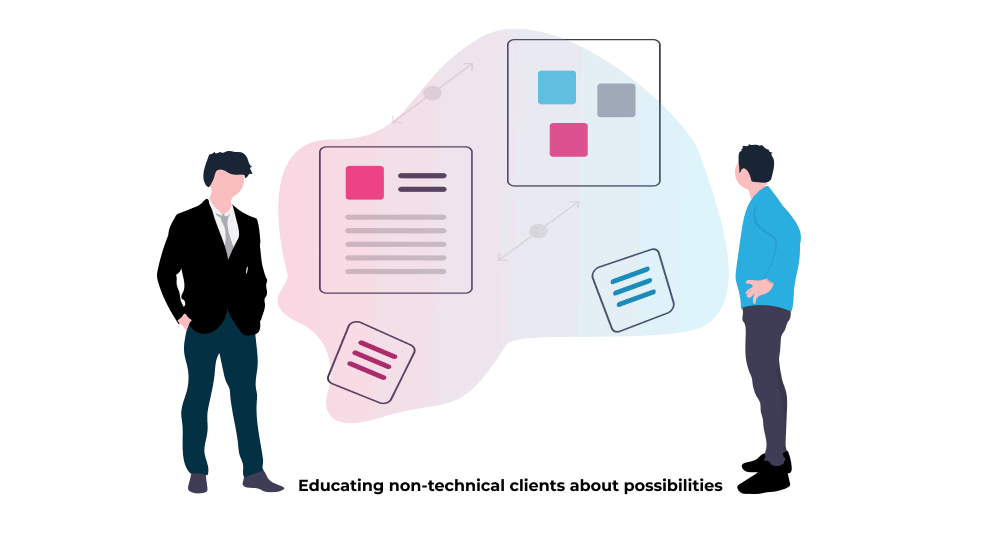Tech startups: 8 common mistakes and how to address them
Edward WongHead of Strategy
With over 20 years in the software development industry in both technical and leadership roles, Edward brings a wealth of experience to the 4mation team.
He is passionate about helping people succeed and empowering people to step up and show how awesome they can be.

Edward Wong
Head of Strategy
When entering the world of tech startups, having the vision, passion and motivation are only just the prerequisites. According to The Harvard Business Review, two-thirds of start-ups never show a positive return. Many articles explore why from a business perspective and provide recommendations for Product-Market Fit, Cash Flow Management, Team/Vendor selection and the like.
As a technology company, we see issues from a different perspective that are often not discussed. For example, Founders that we speak to are often told that an MVP (Minimum Viable Product) is actual working software that they can use to test the market. But, this isn’t necessarily the case.
In this article, we’ll explore some of the common mistakes tech startups make, the impact that those mistakes can have and what to do to address them.
Mistake #1 – “I’ve got storyboards/workflows/ideas/designs/etc, I just need someone to build it for me.”
You’ve done all of the research and groundwork, and you have lots of diagrams and wireframe drawings of how your system should work. You know what it’s going to look like and what it’s going to do. You’re all set, and you need someone to build it.
At 4mation, we see this a lot, and it’s heartbreaking.
Founders have (rightfully) invested a lot of time and potentially money into their idea. They’ve asked their family, they’ve talked to their friends. However, they’ve gone and talked to all the people who are most likely to say to them, “that’s a great idea”, without really thinking about why they would pay money on an ongoing basis to make it happen. Remember, for a startup to succeed, you either need volume or you need repeat sales (ideally both).
If design work has been done, it’s usually great, looks impressive and seems quite detailed. It meets all of your requirements, but that doesn’t mean that it solves any real-life problems in ways that your customers want them to be solved.
We recommend that our clients take the time and effort to gather unbiased feedback. If you have the resources to do it yourself, start by asking a random group of people purely about the problem, with questions such as:
- How much of an issue is it?
- How often do they have the problem?
- What do they do now?
A final tip – resist the urge to talk about the solution. The purpose is purely to gather information, not pitch the solution… yet.

Mistake #2 – “My advisor told me I need to build an MVP.”
A Minimal Viable Product (MVP) might not be what you think it is. Eric Ries, author of “The Lean Startup” writes, “the minimum viable product is that version of a new product which allows a team to collect the maximum amount of validated learning about customers with the least effort.”
The thing to realise here is that an MVP isn’t necessarily software! It can be a survey to gather feedback or goal tracking via google analytics on a home page. The idea is that we are taking the next logical step in understanding the customer’s appetite for your product or service.
When clients don’t clearly understand the size of their target market and their appetite for the product, we help them build a simple landing page to gather a group of potential users – thus gauging interest.
If you find that there isn’t the demand that you thought there would be, you can pivot early without spending a fortune building a solution that no one wants.
Also, when it comes time to build the solution, resist the temptation to add everything that you think the solution needs. Again, what you’re building might not be what your customers want – so only build enough for the customer to be interested and enough for them to want more.
Bearing in mind Mistake #1 above, customer feedback is one of your most valuable resources with an MVP. So don’t forget to factor in several rounds of feedback.
Mistake #3 – “I didn’t know that the developer owned the IP!”
Unfortunately, we’ve heard far too many horror stories of tech startups being locked into vendors because they didn’t own the IP.
According to the Australian Government’s IP Australia Website, “you will not own any intellectual property rights in the developed material unless you enter into a written agreement with the contractor that specifically assigns copyright in the software to you”.
Often, this discovery is not made until the relationship with the developer has soured. If the developer refuses to relinquish the IP rights, there doesn’t seem to be very much that you can do about it, apart from starting all over again.
We recommend that when you review the contract with a vendor, check for an IP clause. If the vendor is unwilling to assign IP to you, reconsider working with them.

Mistake #4 – “Can you give me your best price?”
Software development agencies charge on a time and material basis, meaning they don’t make money from volume sales. By all means, question the amount of time estimated on specific items – you may find assumptions were made that may be incorrect.
If you do try and squeeze the vendor on the overall price, chances are they will make it happen by reducing the total time spent on your work, forcing them to cut corners, which compromises quality.
Be wary of development agencies that “throw things in” to win the deal. Time is the most important asset that an agency has. Ask yourself if you want to work with people that are willing to compromise on that.
Please talk to multiple vendors and compare their estimates. When you find a significant difference, take the time to understand why, rather than simply going with the cheapest option.
Mistake #5 – “Can you give me a fixed price for this entire scope of work?”
Similar to Mistake #4 – Software development involves inherent ambiguity, especially for Startups, where the solution can change depending on factors such as feedback, customer engagement and market forces. As development progresses, you will often think of better ways to get things done, which cannot be accommodated if the project is scoped against a fixed price.
Also, be aware that there is likely to be a significant element of trial and error. Testing and experimentation is a natural part of solution development – no one can get it right all the time. This is especially true if your solution has never been done before.
You should expect changes to happen – so asking for a fixed cost for a fixed set of features isn’t necessarily advantageous to you, either.
We know that you have a budget to work towards, so we recommend that you look for vendors who can articulate how they can work within a budget and their process for handling changes to scope.

Mistake #6 – “I need you to tell me how much this will cost” or “I can’t give you a budget.”
Unfortunately, we also see many tech startups who don’t know how much they’re willing to invest in their solution. Custom software, by definition, can be built in any number of ways. If you either cannot or will not disclose how much you’re willing to invest, the implication is that the vendor should come up with the cheapest possible option.
It means that you’re asking vendors to take a stab in the dark rather than develop the best solution that will fit within your budget. What you may get from this isn’t necessarily a fair representation of what a vendor can do.
If you genuinely don’t know how much you should be spending, you will need to put some time into working out your business model.
Mistake #7 – “Can’t talk – really busy.”
Communication is the cornerstone of an effective partnership with any development team. We’ve found a distinct correlation between how accessible our clients are and the quality of the results that we can generate for them.
So our advice is to ensure that you have available time. Or, if not, delegate decision-making responsibilities to people who have time.
We use multiple communication tools. Here is a quick guide to the three main communication channels and how we use them
- Instant messaging: When a question needs to be asked or answered, but it’s not urgent
- Phone: When a time-critical discussion is required, or a quick decision needs to be made
- Google Meet/Zoom: For our scheduled meetings

Mistake #8 – “I need a custom solution.”
4mation is a custom development agency, so it might sound a bit strange when we’re saying this is a mistake. Bear with us, though, as we explain why.
Most solutions that we come across usually fall into the following categories:
- Ecommerce (either product or food)
- Bookings System
- Brochure Website / Community Management
- Workflow Management
- Management / Reporting System
- Something completely different
SaaS (Software as a Service) platforms have solved almost all of these categories, and the rest are usually solved via customisations and integrations of various other SaaS platforms. The advantages here are twofold:
- You get a lot of functionality “out of the box” that would take months or even years to build.
- Ground-up builds are highly likely to contain security vulnerabilities that you won’t know about until after you’ve been attacked.
Tech startups can make a mistake in thinking that their solution is unique, has never been done before, and needs an entirely ground-up custom solution. Nine times out of ten, it doesn’t. Leverage the power of the available platforms and adapt only for the things that are unique to you.
Hopefully, we have provided you with some helpful tips for embarking on your journey as a tech startup. You will be working with vendors, so it’s essential to choose the one you’re comfortable with.
If you are unsure how to proceed and need advice, please feel free to reach out. Our strategy service is designed to help you chart a way forward.
4mation is a custom software development agency that has worked with numerous tech startups over the past twenty years. If you would like to speak to us about your project, don’t hesitate to get in touch with us.
Need help with your digital strategy?
About The Author
Edward Wong
Edward Wong is an accomplished professional with over two decades of experience in software development, blending technical prowess with strong leadership skills. He is dedicated to fostering success and empowering individuals to showcase their capabilities, making him an invaluable asset to the 4mation team.
